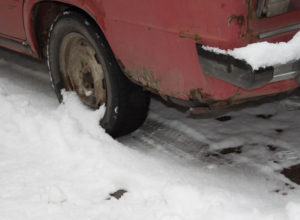
Cosmetic corrosion in a vehicle
The quality and durability of automotive exterior finishes has improved dramatically in the last 20 to 30 years. The dismal corrosion protection performance of the 70’s and 80’s still within the memory of many car owners today. In the past a new car owner, especially those in the North Eastern North America, could consider themselves lucky of cosmetic corrosion or blistering didn’t start to appear on the exterior of their vehicle within the first couple of years of ownership. Perforation corrosion would soon follow with extensive corrosion manifesting itself in the first 4 or 5 years of a vehicles life.
These days it is considered routing for a vehicle to go for a decade without any evidence of exterior cosmetic corrosion. Indeed many OEM’s now offer 10 year warranties against perforation corrosion. What’s changed? One of the biggest factors in this improved corrosion performance is that manufacturers are using much better pre-treatment coatings on their steel structures. A thin layer of zinc phosphate used to the standard steel pre-treatment coating before a top coat system was applied. The primary benefit of the pre-treatment was to provide improved adhesion for the top coat system with minimal corrosion protection achieved.
Today’s vehicles have much improved coating systems where the coating systems are designed specifically to provide corrosion protection as well as adhesion for top coat systems. Also greatly improved are the environmental simulation tests available to the industry to evaluate the effectiveness of these systems.
Up until very recently the standard corrosion test was the ASTM B117 neutral salt spray test. Originally developed way back in late 1930’s , the test method has remained almost the same in the intervening 80 years. While the test had reasonably good correlation for galvanized steel structures exposed to marine environments it never had good correlation with the blistering type of corrosion evident on vehicles.
In the 1990’s automotive manufacturers began to research new corrosion testing methods which would provide better correlation with real world corrosion results. The result of this research was the cyclic corrosion test. As opposed to the steady state high humidity environment of the neutral salt spray test, a cyclic corrosion test usually cycles between different environments. A test can include:
* A salt spray phase similar to a neutral salt spray,
* An air drying phase which can be done at ambient or elevated temperatures.
* A condensation humidity phase, usually performed at elevated temperature and 95 to 100% relative humidity
* A wetting or condensation phase.
* A cycling humidity phase.
Manufacturers discovered that these cyclic corrosion tests correlated very well with the real world performance however on of the drawbacks cyclic corrosion lab tests was that they greatly increased exposure time. Where a standard neutral salt spray test might run for two weeks or in extreme cases as long as 6 weeks, a standard cyclic corrosion test would run for six weeks with the longest tests running for sixteen weeks.
Cyclic corrosion tests today have almost completely replaced the neutral salt spray test for corrosion evolution in the automotive industry.
